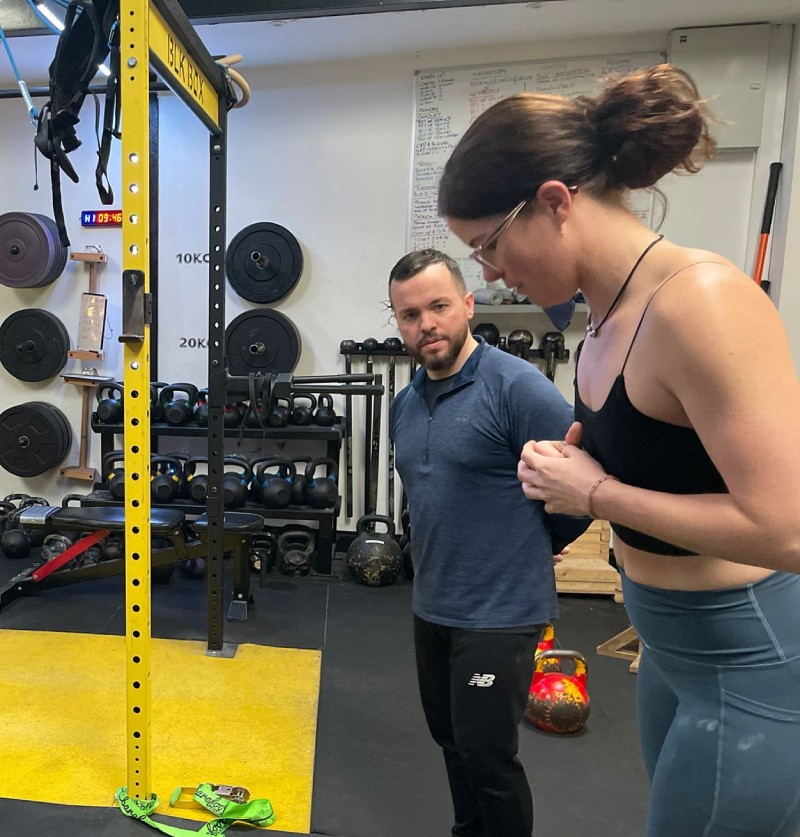Are you looking to make your arm stronger and improve your upper body? Pilates arm exercises might be just what […]


Do you want strong, toned legs that show confidence?
With the right exercises and your commitment, you can make that happen.
Pilates gives you a full path to strengthen your legs, not only by building muscle but also by enhancing their flexibility and alignment.
Through mindful movements and targeted exercises, Pilates supports you in shaping and strengthening your legs thoroughly, giving you a lean, toned appearance that reflects confidence.
According to the National Library of Medicine, Pilates exercises significantly improved leg muscle strength and flexibility in participants.
Keep reading to find a full Pilates leg workout guide that will help you achieve your fitness goals.
Let's shape and strengthen together!
Start your Pilates leg workout by understanding the basics of Pilates and how it can benefit your legs.
Pilates is a gentle form of exercise that focuses on making your core muscles stronger and it's also really good for toning and strengthening your legs.
When you're doing Pilates, you're not just moving around randomly.
You're actually targeting specific muscles in your body with each move.
The best part about this is it helps to make your muscles stronger, gives them more energy so they can keep going for longer, and even makes you more flexible.
And it's super gentle on your joints, so you don't have to worry about causing any strain or discomfort.
If you're looking for a workout that's not only effective but also safe and gentle, Pilates is definitely the way to go.
It's a great choice for your whole body, but especially for those legs of yours.
Before we begin our Pilates leg workout, let's talk about why warming up is important.
Like with any exercise, doing a proper warm-up helps get your body ready for what's coming next.
Spending a few minutes on a proper warm-up can really improve how well you do in your workout and keep you from getting hurt.
Let's get those muscles warmed up!
Check out these easy warm-up exercises that will help loosen you up and prepare you for your workout.
Leg Swing is a simple yet effective warm-up exercise.
It's great for getting your hip joints moving and getting the blood flowing to your legs before you start your workout.
To begin, grab onto something steady, like a chair or wall, to stay balanced.
Next, swing one leg back and forth smoothly and gently.
Try doing this about 10 times on each leg.
This exercise is awesome because it helps loosen up your hip joints, especially if you've been sitting for a long time.
It also gets the blood moving in your legs, which is important for getting your muscles ready to work during your workout.
This easy but important exercise is really helpful for making your ankles more flexible and mobile, which is important for staying steady during your workout.
Whether you're standing or sitting, lift one foot off the ground and start making gentle circles with your ankle.
Rotate in one direction for a few times, then switch to the other direction.
Try to do about 10 circles in each direction on each foot.
Even though this exercise seems simple, it's really good for you.
It helps loosen up your ankle joints and makes them more flexible.
This helps keep you steady during your workout, whether it's Pilates or something else.
This is a classic exercise that's great for working out your legs and glutes.
To do a squat, start by standing with your feet about hip-width apart.
Then, lower your body down as if you were sitting back in a chair, making sure to keep your chest up and your knees in line with your toes.
Press through your heels to stand back up, squeezing your glutes at the top.
Repeat this movement 10 times.
Squats are awesome because they activate the muscles in your legs and glutes, getting them ready for the rest of your workout and they're a simple yet effective exercise that anyone can do.

Now that you're warmed up, let's move on to the main workout.
This Pilates leg routine includes several exercises that target the main muscles in your legs, like the quadriceps (front of your thighs), hamstrings (back of your thighs), glutes (your butt), and calves (back of your lower legs).
As you go through these exercises, make sure to pay attention to your breathing and keep good form.
This helps you get the most out of each movement and prevents injury.
Leg circles help tone your thighs, improve hip mobility, and engage your core.
Take your time with each movement to ensure you maintain proper form and get the most out of this exercise.
Here’s how to do Leg circles:
The Single Leg Bridge is great for building strength in your glutes and hamstrings, and it also helps improve balance and stability. If you're just starting out, you might feel a bit shaky, but with practice, you'll get stronger and more stable.
Here's how to do it:
Side leg lifts are excellent for strengthening the muscles on the side of your hip and thigh.
They help improve stability and balance, making everyday movements easier and reducing the risk of injury.
Here’s how to do it:
The Pilates Chair Pose is a great way to target and strengthen your leg muscles while also working on your balance and core stability.
This is a simple yet effective exercise for strengthening your legs and core.
Pilates Chair Pose:
After finishing up your Pilates leg workout, it's important to take a few minutes to cool down and stretch your muscles.
This helps to prevent soreness and stiffness later on.
Let's focus on some easy stretches for your legs, hips, and lower back to help you relax and improve your flexibility.
To do a forward fold, start by standing with your feet about hip-width apart.
Then, gently bend forward from your hips, reaching down toward your toes.
If it feels better, you can bend your knees a bit.
Stay in this position for 30 seconds to 1 minute, feeling the stretch in the back of your legs (your hamstrings) and your lower back.
Don't forget to take deep breaths and let yourself relax into the stretch.
To do this, start by lying on your back with your knees bent and your feet flat on the floor.
Next, cross one ankle over the opposite knee, creating a figure four shape with your legs.
Then, reach your hands through the gap between your legs and gently pull the knee that's crossed over toward your chest.
Hold this position for about 30 seconds, feeling a gentle stretch in your hip and glute muscles.
Afterwards, switch sides and repeat the stretch on the other leg.
It is a relaxing yoga pose that helps to stretch out your back, hips, and thighs.
To do it, start by kneeling on the floor with your knees hip-width apart.
Then, sit back onto your heels and lower your upper body down towards the floor, extending your arms out in front of you.
Rest your forehead on the mat and take slow, deep breaths, focusing on relaxing your lower back and hips.
Hold this pose for 1-2 minutes to release any tension and promote flexibility in your hips and thighs.
Doing Pilates regularly can help you see improvements in your strength, flexibility, and overall fitness.
Aiming for 2 to 3 times a week is usually a good idea.
This schedule lets your body rest and recover between workouts, which helps you get better and avoid getting too tired.
Whether you're doing Pilates at home or in a class, aim for a few sessions each week to get the most out of it.

Pilates is awesome for making you stronger, more flexible, and more in tune with your body.
But for some people, it might not be all you need to stay fit and healthy.
It's a good idea to mix things up and include different types of exercises in your routine.
That means you're taking care of all your muscles and keeping your whole body healthy.
Besides Pilates, you could try adding things like walking or biking for cardio or using weights or resistance bands for strength training.
Whatever gets you moving and feeling good is the way to go!
Building these exercises into your usual fitness routine, you can make your legs stronger and more sculpted while also getting better flexibility and balance.
Pay attention to how your body feels, change any moves that you need to, and always focus on doing them right.
Sticking with it and doing it regularly will make great progress towards having strong, toned legs and feeling healthier and happier.
If you're searching for physio-led Pilates, look no further.
We offer a supportive environment with elite trainers who are dedicated to providing personalised attention and expert guidance to help you achieve your fitness aspirations.
Browse our selection of articles and videos today for more inspiration and guidance on your fitness journey.
Choose Primal Lisburn Gym and experience the best in fitness training and support.
Are you looking to make your arm stronger and improve your upper body? Pilates arm exercises might be just what […]
Tired of hiding your arms under long sleeves because they lack the definition you desire? People dream of having well-sculpted […]
Looking to sculpt a stronger, more defined upper body? Dumbbells are your perfect workout companion! They’re super flexible and can […]
